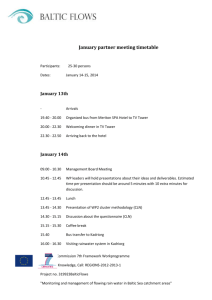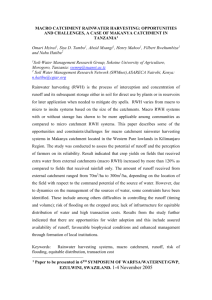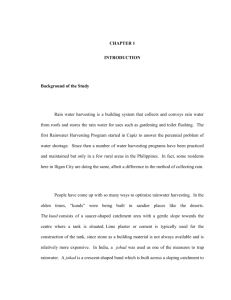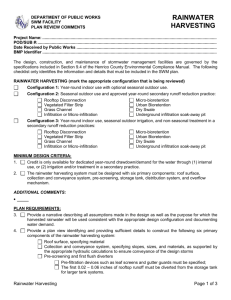Lesson Plans
advertisement
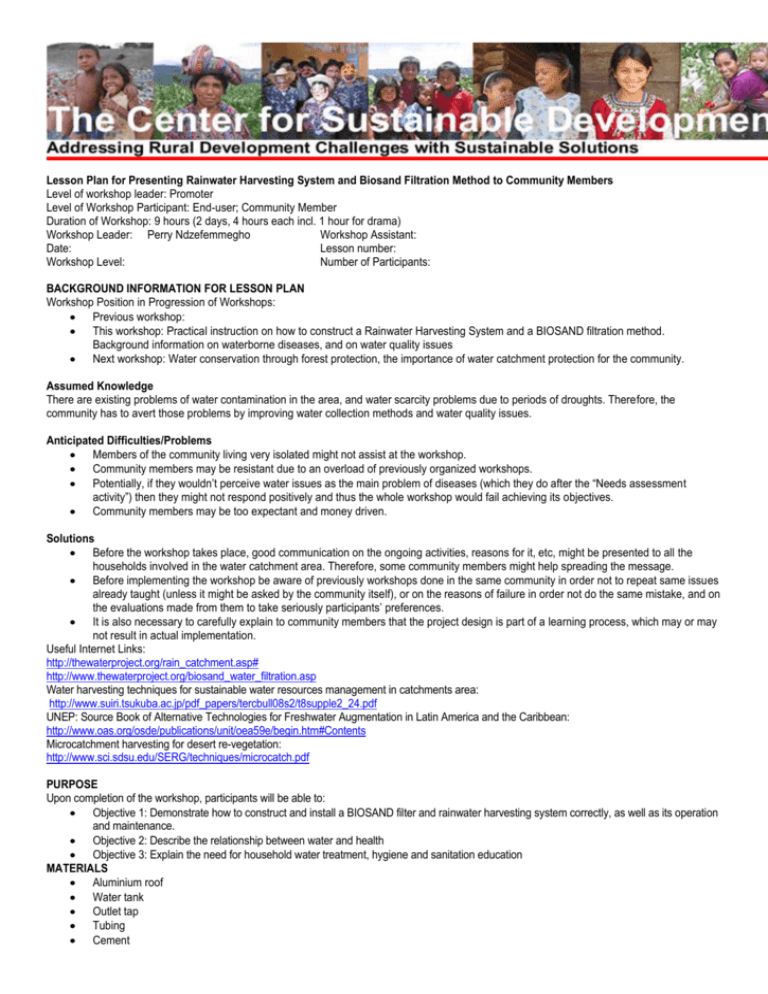
Lesson Plan for Presenting Rainwater Harvesting System and Biosand Filtration Method to Community Members Level of workshop leader: Promoter Level of Workshop Participant: End-user; Community Member Duration of Workshop: 9 hours (2 days, 4 hours each incl. 1 hour for drama) Workshop Leader: Perry Ndzefemmegho Workshop Assistant: Date: Lesson number: Workshop Level: Number of Participants: BACKGROUND INFORMATION FOR LESSON PLAN Workshop Position in Progression of Workshops: Previous workshop: This workshop: Practical instruction on how to construct a Rainwater Harvesting System and a BIOSAND filtration method. Background information on waterborne diseases, and on water quality issues Next workshop: Water conservation through forest protection, the importance of water catchment protection for the community. Assumed Knowledge There are existing problems of water contamination in the area, and water scarcity problems due to periods of droughts. Therefore, the community has to avert those problems by improving water collection methods and water quality issues. Anticipated Difficulties/Problems Members of the community living very isolated might not assist at the workshop. Community members may be resistant due to an overload of previously organized workshops. Potentially, if they wouldn’t perceive water issues as the main problem of diseases (which they do after the “Needs assessment activity”) then they might not respond positively and thus the whole workshop would fail achieving its objectives. Community members may be too expectant and money driven. Solutions Before the workshop takes place, good communication on the ongoing activities, reasons for it, etc, might be presented to all the households involved in the water catchment area. Therefore, some community members might help spreading the message. Before implementing the workshop be aware of previously workshops done in the same community in order not to repeat same issues already taught (unless it might be asked by the community itself), or on the reasons of failure in order not do the same mistake, and on the evaluations made from them to take seriously participants’ preferences. It is also necessary to carefully explain to community members that the project design is part of a learning process, which may or may not result in actual implementation. Useful Internet Links: http://thewaterproject.org/rain_catchment.asp# http://www.thewaterproject.org/biosand_water_filtration.asp Water harvesting techniques for sustainable water resources management in catchments area: http://www.suiri.tsukuba.ac.jp/pdf_papers/tercbull08s2/t8supple2_24.pdf UNEP: Source Book of Alternative Technologies for Freshwater Augmentation in Latin America and the Caribbean: http://www.oas.org/osde/publications/unit/oea59e/begin.htm#Contents Microcatchment harvesting for desert re-vegetation: http://www.sci.sdsu.edu/SERG/techniques/microcatch.pdf PURPOSE Upon completion of the workshop, participants will be able to: Objective 1: Demonstrate how to construct and install a BIOSAND filter and rainwater harvesting system correctly, as well as its operation and maintenance. Objective 2: Describe the relationship between water and health Objective 3: Explain the need for household water treatment, hygiene and sanitation education MATERIALS Aluminium roof Water tank Outlet tap Tubing Cement Sand, grains Possible filter materials. If available water quality testing tool kit. Cylinder with outlet pipe for biosand filtration BRIEF SUMMARY OF LESSON Introduction: Activity 1. Water treatment, water hygiene and sanitation Workshop Leader: Statement of Purpose: Tell the participants what they’ll be able to do as a result of the lesson. Guided Practice: Activity 2. Rainwater Harvesting System. Introduction Workshop Leader with Workshop Participants: Ice Breaker: Sing a song or play a game. Activity 3. Biosand filtration Activity 4. Workshop Conclusion, Follow-Up, Monitoring and Evaluation BEGINNING OF LESSON: INTRODUCTION Activity 1. Water treatment, water hygiene and sanitation Purpose Explain the health risks and negative impacts associated with drinking contaminated water. Demonstration of village hygiene and sanitation through drama/sketches. Time 60 minutes Materials Costumes, water pails Activity 2. Rainwater Harvesting System Purpose Describe the main components of any rainwater harvesting system for domestic use Identify, assess and select appropriate rainwater harvesting technologies to meet local needs and conditions Construct various rainwater harvesting system components and instruct users on its correct installation, operation and maintenance Time 3 hours (including a 15 minute ice-breaker) Materials Drawings/Posters Rainwater catchment surface (it can be at the roof of a household’s community member) Conveyance system (pipes) Water storage tank If available water quality testing tool kit What to do Workshop Leader 1. Introduction to workshop 2. Ice Breaker: Game: tree, bird, fire. 3. Content of the activity: 1. Design of the RWS: A RWH system consists of a rainwater catchment surface, conveyance system, and water storage tank(s). Following considerations will be presented: a) Detailed investigations should be conducted to determine the actual demand for rainwater. b) In the peak dry season, a procedure of water rationing should be put in place when the water level in the tank drops below a certain point to avoid emptying the tank. c) The concept of first flush (foul flush), where the initial batch of rainwater is directed away from the tank, should be supported and simple, easy-to-operate flushing devices provided. d) Despite the different storage tank designs, it will be appropriate to use plastic storage tanks to prevent regular maintenance costs. 2. Construction and installation of a RWH: Household rainwater catchment systems can be constructed by, and maintained at, the community or individual level, with a minimum of training by skilled technicians. a) Both the conveyance pipes and the storage tanks should be constructed of inert material in order to avoid adverse affects on water quality. b) A water balance statement for each month of a calendar year is prepared and the cumulative excess (supply minus demand) available at the end of each month is calculated. The highest cumulative excess water is the required capacity of the storage. A rough estimate of storage can be obtained: Storage= Consumption per capita X Nº of people in household X Longest average dry spell days 3. Operation and maintenance: The major concern is to prevent the entry of contaminants into the tank while it is being replenished during a rainstorm. The following guidelines will be provided for the operation of the RWH. a) Use an installed first flush (or foul flush) device, which directs the initial batch of rainwater away from the tank to avoid the entry of debris from the catchment area into the tank. b) Check and clean the storage tank periodically. All tanks need cleaning, and their designs should allow for the thorough scrubbing of the inner walls and floors using a chlorine solution (followed by thorough rinsing). This sometimes can be difficult to accomplish without emptying the tank. c) Chlorinate the storage tanks as necessary if the stored water becomes contaminated using slow-release chlorine tablets. (Most times the rainwater is used without treatment). d) Maintain gutters and down pipes. A good time to inspect gutters and down pipes is while it is raining, so that leaks can easily be detected. Regular cleaning is necessary to avoid contamination. 4. DEMONSTRATION: Together the participants will construct a RWH system. Choose a house with a suitable roof as a catchment area. After the first coming rain, participants and workshops leaders should gather again and discuss problems that might appear. Activity 3. Biosand filtration Purpose Describe the operation and maintenance of a biosand filter. Demonstrate how to construct and install a biosand filter correctly Time 3 hours (including a 15 minute ice-breaker) Materials Drawings/Posters Sand, grains Cylinder with outlet pipe If available water quality testing tool kit What to do Workshop Leader 1. Introduction to workshop 2. Ice Breaker: Game: tree, bird, fire. 3. Content of the activity: 1. Design of a sand filter: a) The cylinder is filled with suitable sand. The fine sand has a large surface area, which traps dirt more easily b) A layer of coarse grains on the bottom will prevent the finer sand on the top from blocking the outlet, located at the bottom of the unit. c) A diffuser plate is located some distance above the sand. Made from a perforated plate, the diffuser protects the sand and the biofilm it contains from scouring effect that would occur when water is poured into the filter. d) Despite the different storage tank designs, it will be appropriate to use plastic storage tanks to prevent regular maintenance costs. e) . Between the diffuser plate and the top of the sand is the rest level of the water. Generally, it is designed to purify water through a process which include; mechanical trapping, adsorption/attraction, predation and natural death. 2. Construction. a) The filter container can be constructed out of concrete or plastic. The container is filled with layers of sieved and washed sand and gravel (also referred to as filter media). There is a standing water height of 5 cm above the sand layer. b) A biological layer of microorganisms (also known as the biolayer) develops at the sand surface, which contributes to the water treatment. 3. Operation and maintenance: a) The biolayer is the key pathogen removing component of the filter. Without it, the filter is significantly less effective. It may take up to 30 days to establish the biolayer depending on inlet water quality and frequency of use. b) Contaminated water is poured into the top of the filter on an intermittent basis. The water slowly passes through the diffuser, and percolates down through the biolayer, sand and gravel. Treated water naturally flows from the outlet. c) A pause period is needed between uses to allow time for the microorganisms in the biolayer to consume pathogens in the water. The recommended pause period is 6 to 12hours with a minimum of 1 hour and maximum of 48 hours. d) Slow sand filters should be cleaned by scraping the bio-film and/or the top sand layer. The flow rate in slow sand filters is therefore usually restored by scraping and removing the top layer of sand, which is where most clogging occurs. Hence, large quantities of backwash water are not required, as it occurred with rapid sand filtration. e) The outlet, lid and diffuser should be cleaned regularly using soap and water or a chlorine solution. f) Filters should not be moved after installation. 4. DEMONSTRATION: Together the participants will construct a biosand filter. Activity 4. Workshop Conclusion, Follow-Up, Monitoring and Evaluation Purpose To follow-up and monitor workshop outputs. Time (Duration of project implementation). Materials Project administration (incl. 2 bikes, computers, office stationery etc.)
